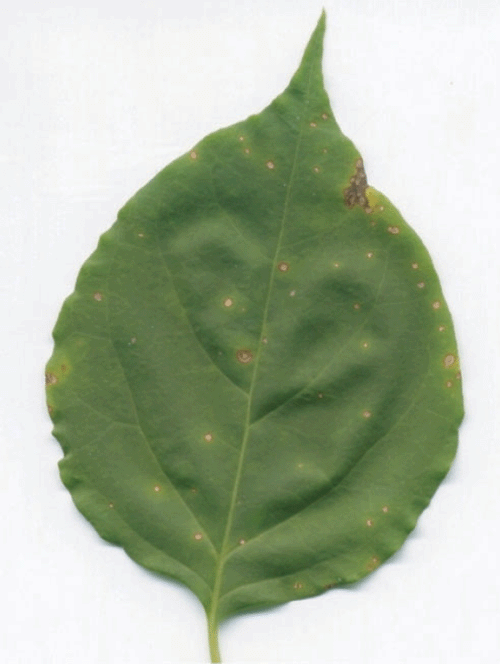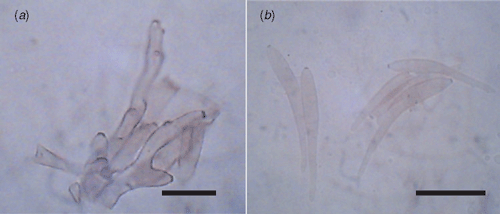First record of Passalora bougainvilleae causing leaf spot of bougainvillea in the Philippines
A. B. Ponaya A and C. J. R. Cumagun A BA Crop Protection Cluster, University of the Philippines, Los Baños College, Laguna 4031, Philippines.
B Corresponding author. Email: christian_cumagun@yahoo.com
Australasian Plant Disease Notes 3(1) 3-4 https://doi.org/10.1071/DN08002
Submitted: 30 November 2007 Accepted: 12 January 2008 Published: 30 January 2008
Abstract
A survey for cercosporoid fungi was conducted in residential gardens in Bay, Laguna, Philippines. One of the specimens was a bougainvillea with leaf spots on both young and mature leaves. The specimens were collected and studied in the laboratory for further identification of the causal pathogen. It was found out that leaf spots were caused by Passalora bougainvilleae. Leaf spot of bougainvillea caused by P. bougainvilleae is reported for the first time in the Philippines.
Bougainvillea (Bougainvillea spectabilis) is a deciduous vine in the Nyctaginaceae, which is commonly found in warmer places and recognised by its beautiful bracts (Hay 1960). This ornamental can be grown in pots for decorative purposes (Bush-Brown and Bush-Brown 1955) and can also be planted out in a border (Hay 1960). Bougainvillea is popularly used for gardening and is propagated through half-hard cuttings. Provided with favourable conditions and climate, bougainvillea can be considered as a strong grower (Hume 1954).
Passalora bougainvilleae, formerly known as Cercospora bougainvilleae, has been observed to cause leaf spots on bougainvillea in Argentina, Cuba, Jamaica, Thailand, USA and Venezuela (Ellis 1976; Nakashima et al. 2007). The same pathogen was found in Florida in 1963, where it was considered to be a serious problem due to its widespread distribution in almost 53 locations in the state, causing leaf spots on Bougainvillea glabra and Bougainvillea spectabilis (Sobers 1964).
A survey of cercosporoid diseases was conducted in residential gardens of Bay, Laguna, south of Manila, Philippines. On July 2007, leaves of bougainvillea exhibiting spots, were collected and studied in the laboratory for the identification and further characterisation of the causal pathogen. The same symptoms and morphological characteristics were found based on reports of the pathogen. The fungus causing leaf spot of bougainvillea was identified as Passalora bougainvilleae as described by Ellis (1976).
Leaf spots were visible on both leaf surfaces. Spots were brown, circular to sometimes angular and irregular in shape, 0.3–4.0 mm in diameter with dark brown to black margins often surrounded by yellow halos (Fig. 1). Fungal masses were found on the upper leaf surface surrounding the lesions. As spots increased their size, lesions became necrotic and sometimes led to shot holes.

|
Conidiophores were pale brown, smooth, straight to geniculate, in small fascicles (6–7), aseptate, 13–83 µm long × 6–10 µm wide (Fig. 2a). Conidiogenous cells were monoblastic to polyblastic, with conspicuous and darkened scars. Stroma was lacking. Conidia were pale brown, solitary, smooth, slightly curved, cylindrical, had 3–7 septa and were 30–67 µm long × 6–13 µm wide (Fig. 2b). The base of the conidium was truncate. Hila were thickened and darkened, with one hilum per conidium.

|
Specimens have been deposited in the Mycological Herbarium, University of the Philippines Los Baños with accession number 11672. This is the first record of Passalora bougainvilleae on bougainvillea in the Philippines.
Nakashima C,
Motohashi K,
Meeboon J, To-anun C
(2007) Studies on Cercospora and allied genera in Northern Thailand. Fungal Diversity 26, 257–270.
[Revised on July 1980, verified 14 January 2008]


